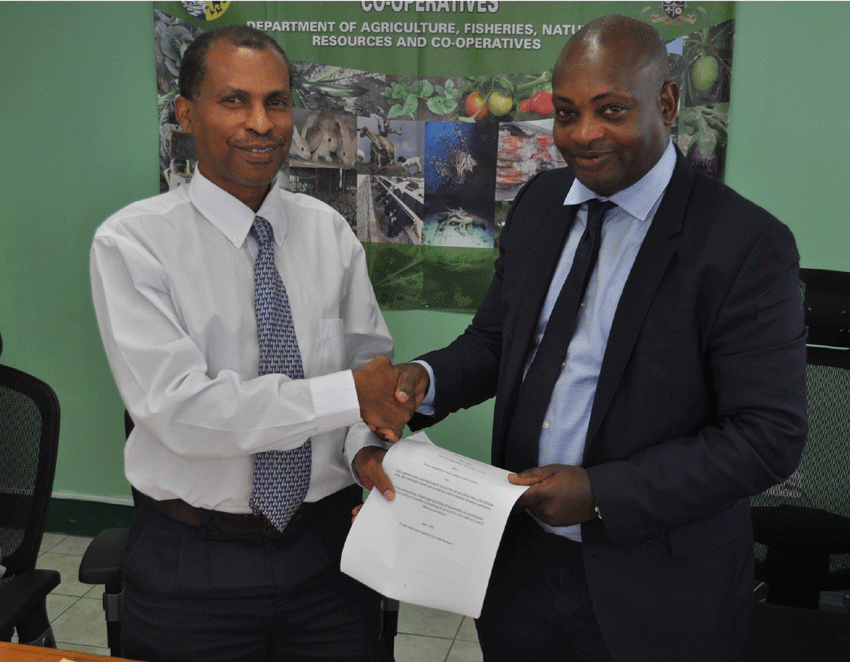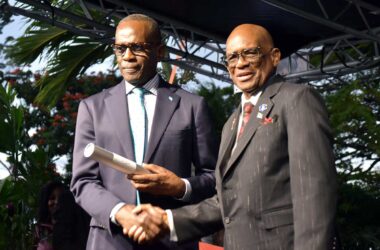Saint Lucia Signs Snakebite Accord
MARTINIQUE is well known and has long been the destination of choice for medical referrals from St. Lucia, both for routine as well as emergency medical evacuations.
Less well-known, however, is that La Meynard (CHUM) is a University Hospital and that St. Lucian medical personnel, as well as Ministry of Health officials, have benefited from training programmes during the past several years.
More recently, in preparation for the manning of the new Owen King-European Union (OKEU) hospital, training in such areas as Critical Care & Radiology has been conducted by the CHUM, both in St. Lucia and Martinique.
In a recent ‘first’ for the Caribbean region, the Ministry of Agriculture on Wednesday 13th June signed a Memorandum of Agreement (MOA) on behalf of the Forestry Division with the Caribbean Doctors Association (CDA), for cooperation into various aspects of the management of the endemic snake, the Fer-de-Lance (Bothrops Caribbeaus).
CDA Secretary General, Saint Lucia’s Keats Compton, in an exclusive interview with The Voice, explained the background to the recent historic development.
According to Compton, “Following the designation of snakebites as a neglected tropical disease by the WHO in 2017, the World Health Assembly (WHA) mandated the WHO to develop a comprehensive plan to combat the disease.
“Since that time Dr. Dabor Resiere, a resident toxicologist and critical care specialist at the CHUM, has been conducting research into an anti-venom for the Fer-de-Lance, as the Martinique variety (bhotrops lanceolotus) is a very close relative of Saint Lucia’s Fer-de-Lance.”
Compton disclosed that Dr. Resiere is currently attending a conference on snakebite envenoming in the Netherlands, having spent six months in Costa Rica last year conducting joint research with Professor José Maria Guiterrez, who developed the anti-venom currently in use in St. Lucia.
The 2019 symposium will be held in Martinique.

According to Mr Compton, “St. Lucia’s cooperation with Martinique on the treatment of snakebite dates to 2002, with the very first evacuation of a bite victim to the CHUM.
“This effort was recognised internationally in an article published in the American Journal of Tropical Medical Hygiene, co-authored by Dr. Martin Didier.”
Dr. Didier and Dr. Resiere also made presentations at an International Snakebite Symposium in French Guyana in 2016, which sought, among other objectives, to work towards the development of common anti-venom for the multiple varieties of poisons.
According to the CDA Secretary General, “Snakes have historically had a terrible press, perhaps due to biblical, among other injunctions.
“This MOA will hopefully succeed in providing a better understanding of the potential medical benefits of the venom, as well as the need to manage its coexistence with the rest of our society.”
The CDA is a French-registered, non-profit Association, dedicated to socio-medical interventions and two well-known local medical practitioners, Dr Didier and Dr Romel Daniel are both members.
Dr. Resiere, who is also the CDA President, was accompanied at the signing by Dr. Hossein Medaouhi, the head of the Intensive Care Unit (CHU) at La Meynard and also a CDA member.
According to Mr Compton, Resiere and Medaouhi “were in St. Lucia for discussions with government officials on healthcare cooperation.”
He also had much praise for the efforts of the persons and entities in Saint Lucia and Martinique who helped make the MOA possible.
“In this instance,” he told The Voice, “the CDA is pleased to partner with the Ministry of Agriculture, as well as the St. Lucia National Trust, which in turn has been collaborating with the Forestry Department, Durrell Wildlife Conservation Trust and Flora and Fauna International, in a stakeholder consultation on a management programme for the fer-de-lance.”
“That project,” he said, “has been assisted by the Global Environment Facility’s Small Grants Programme.”














